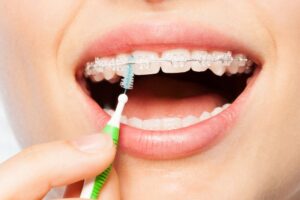
Getting braces can change many of your daily habits and routines, but sometimes change isn’t always bad—it’s just new! Although brushing and flossing with braces can seem more difficult, the key is to invest in the right oral hygiene instruments and be diligent about maintaining good at-home habits. By implementing these helpful tips, you can keep your smile cavity-free throughout your treatment, ensuring your timeline doesn’t get set back. Read on to learn how you can be an effective brusher and flosser if you have braces.
How to Brush with Braces
You can opt to use either a manual or electric toothbrush, each featuring their own unique benefits depending on your technique and abilities. It’s important to brush at least twice a day for two minutes each time, but brushing after meals is also beneficial and can help keep your oral health on the right track.
When brushing with braces, be sure to follow these steps:
- Rinse your mouth with water to dislodge any debris.
- Place fluoridated toothpaste on your toothbrush and begin brushing at a 45-degree angle along your gumline.
- Place the toothbrush on the top of your brackets so the bristles brush the top of each bracket.
- Reposition your toothbrush at the bottom of the brackets and repeat.
- Brush every tooth both above and below the bracket.
How to Floss with Braces
Flossing can feel especially inconvenient or difficult if you have braces, but it’s important that you do so at least once a day. Follow these helpful tips to be an effective flosser:
- Use about 18 inches of floss.
- Carefully thread the dental floss under the main wire before passing it between the teeth.
- Remove the floss, re-threading it under the main wire, and continue this process until you have flossed between all of the teeth.
- Don’t snap the floss, just glide it against each tooth to remove any lodged debris.
Helpful Oral Hygiene Instruments if You Have Braces
Brushing and flossing with traditional products can prove especially difficult if you have braces, which is why it may be worthwhile to invest in special gadgets. Some of the most helpful oral hygiene products for patients with braces are:
- Electric toothbrushes make it easier to effectively brush above and below each of your teeth. Some of the latest models even help you track your brushing progress via an app on your phone!
- Water flossers make flossing much easier. Instead of having to re-thread traditional dental floss between your archwire every time you go to clean between your teeth, all you have to do is turn your water flosser on and move it around your mouth. The high-powered, flushing force will effortlessly remove lodged debris.
- Interdental brushes are small toothbrushes that act as an alternative to flossing. Traditional toothbrushes have a flat head with bristles on one side. Interdental brushes have bristles that are arranged around the entire brush in the shape of a cylinder. This allows them to reach the nooks and crannies between teeth without the hassle of dealing with dental floss.
With good at-home oral hygiene, you can avoid common dental concerns throughout your treatment, like decay, gum disease, and more. This will help you stay on track with your original treatment timeline by preventing the need for procedures. Although a little extra effort may be necessary to make this happen, it will be well worthwhile!
About the Author
Dr. Rafiq Hirji has over a decade of experience in the dental field as well as post-graduate training in a number of specialty services, including orthodontics. Because of this, he’s able to offer multiple orthodontic treatments in-office, including Invisalign clear aligners and traditional braces. For questions or to schedule an appointment, visit Daily Smiles MacArthur Dental & Orthodontics’ website or call 972-546-4114.
